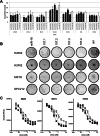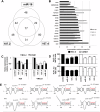Therapeutic potential of synthetic microRNA mimics based on the miR-15/107 consensus sequence
- PMID: 40121357
- PMCID: PMC11976272
- DOI: 10.1038/s41417-025-00885-w
Therapeutic potential of synthetic microRNA mimics based on the miR-15/107 consensus sequence
Abstract
MicroRNA expression is frequently suppressed in cancer, and previously we demonstrated coordinate downregulation of multiple related microRNAs of the miR-15/107 group in malignant pleural mesothelioma (PM). From an alignment of the miR-15 family and the related miR-103/107, we derived a consensus sequence and used this to generate synthetic mimics. The synthetic mimics displayed tumour suppressor activity in PM cells in vitro, which was greater than that of a mimic based on the native miR-16 sequence. These mimics were also growth inhibitory in cells from non-small cell lung (NSCLC), prostate, breast and colorectal cancer, and sensitised all cell lines to the chemotherapeutic drug gemcitabine. The increased activity corresponded to enhanced inhibition of the expression of target genes and was associated with an increase in predicted binding to target sites, and proteomic analysis revealed a strong effect on proteins involved in RNA and DNA processes. Applying the novel consensus mimics to xenograft models of PM and NSCLC in vivo using EGFR-targeted nanocells loaded with mimic led to tumour growth inhibition. These results suggest that mimics based on the consensus sequence of the miR-15/107 group have therapeutic potential in a range of cancer types.
© 2025. The Author(s).
Conflict of interest statement
Competing interests: GR and NvZ hold a patent based on the consensus microRNA sequences described; NM, JW, HB and JM are employees of ENGeneIC. The remaining authors declare no conflicts of interest. Ethics approval and consent to participate: The EnGeneIC Animal Ethics Committee approved all protocols for animal studies. All experiments were performed in accordance with the relevant guidelines and regulations.
Figures






References
MeSH terms
Substances
Grants and funding
LinkOut - more resources
Full Text Sources
Medical
Research Materials
Miscellaneous

